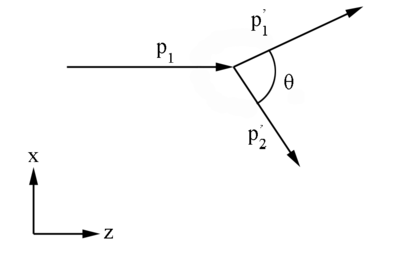Difference between revisions of "Initial Lab Frame 4-momentum components"
Jump to navigation
Jump to search

Figure 1: Definition of variables in the Lab Frame
| Line 47: | Line 47: | ||
| style="background: gray" | <math>\Longrightarrow E\equiv \sqrt{(11000 MeV)^2+(.511 MeV)^2}+.511MeV\approx 11000.511 MeV</math> | | style="background: gray" | <math>\Longrightarrow E\equiv \sqrt{(11000 MeV)^2+(.511 MeV)^2}+.511MeV\approx 11000.511 MeV</math> | ||
|} | |} | ||
| + | |||
| + | |||
| + | |||
| + | ---- | ||
| + | |||
| + | |||
| + | <center><math>\textbf{\underline{Navigation}}</math> | ||
| + | |||
| + | [[Limits_based_on_Mandelstam_Variables|<math>\vartriangleleft </math>]] | ||
| + | [[VanWasshenova_Thesis#Initial_4-momentum_Components|<math>\triangle </math>]] | ||
| + | [[Initial_CM_Frame_4-momentum_components|<math>\vartriangleright </math>]] | ||
| + | |||
| + | </center> | ||
Revision as of 00:48, 16 June 2017
Initial Lab Frame 4-momentum components

Begining with the assumption that the incoming electron, p1, has momentum of 11000 MeV in the positive z direction.
We can also assume the Moller electron, p2, is initially at rest
This gives the total energy in this frame as
where,
This gives,